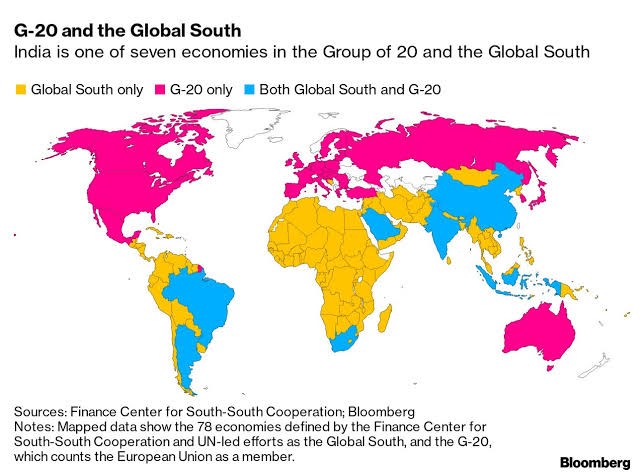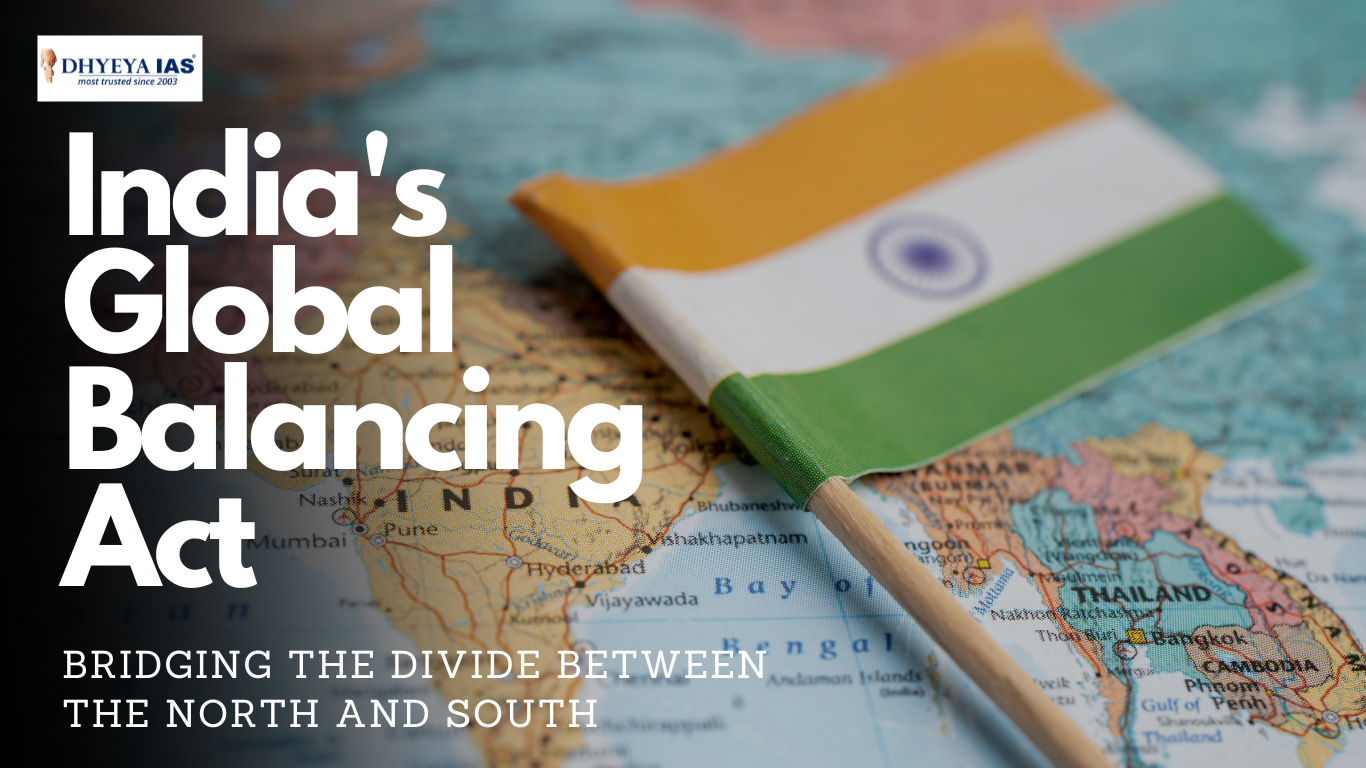India has steadily carved a niche for itself as a nation that bridges the gap between the Global North and the Global South. Recent international events, such as the 18th Pravasi Bharatiya Divas Convention (January 2025) and the 3rd Voice of Global South Summit (August 2024), highlight India's growing leadership in championing the concerns of developing nations while maintaining strong diplomatic and economic ties with advanced economies. This evolving role is shaped by India’s strategic, economic, and geopolitical aspirations.
Understanding the Global North and South:
The Global North primarily includes economically advanced nations such as the United States, Canada, European countries, Japan, and Australia—regions characterized by high industrialization, technological superiority, and economic dominance.
In contrast, the Global South comprises Asia, Africa, and Latin America, where many nations grapple with economic disparities, infrastructural deficits, and development challenges. Despite these differences, both regions rely on each other—while the North depends on the South for labor, markets, and resources, the South benefits from trade opportunities, investments, and technology transfers from the North.

India’s Engagement with the Global North:
1. Strengthening Strategic Partnerships: India has deepened its ties with countries like the United States, the European Union, and Japan through economic collaborations, defense partnerships, and technology exchanges. High-profile visits, such as Jake Sullivan’s (former U.S. NSA) visit to India in January 2025 and PM Modi’s trip to Poland in August 2024, reflect the strengthening of these alliances.
2. Advocating for Inclusive Global Governance: As an active participant in forums like the G20, BRICS, and the United Nations, India has consistently championed reforms that ensure better representation for developing nations. One notable achievement was India’s push for the African Union’s inclusion in the G20 during its presidency in 2023, highlighting its commitment to a more inclusive global order.
3. Leading Climate Action Initiatives: India is at the forefront of global climate action, promoting initiatives such as:
- International Solar Alliance (ISA) – encouraging solar energy adoption worldwide.
- Coalition for Disaster Resilient Infrastructure (CDRI) – enhancing global infrastructure resilience.
- Mission LiFE (Lifestyle for Environment) – advocating sustainable consumption practices.
4. Economic and Digital Diplomacy: India has leveraged its expertise in digital public infrastructure, which has gained recognition globally. Some key innovations include:
- UPI (Unified Payments Interface) – a groundbreaking digital transaction system.
- Aadhaar-based biometric identity system – improving governance and financial inclusion.
5. Addressing Diaspora Concerns: India actively engages with its expatriate communities in the Global North, addressing issues such as visa policies, employment challenges, and diplomatic assistance.
6. Promoting Cultural and Educational Ties: India fosters cross-cultural exchanges through student programs, academic collaborations, and cultural festivals, strengthening its ties with the Global North.
India’s Engagement with the Global South
1. Strengthening South-South Cooperation: India plays a crucial role in enhancing bilateral trade, infrastructure development, and capacity-building initiatives across Asia, Africa, and Latin America.
2. Hosting the Voice of Global South Summits: Since 2023, India has provided a platform for developing nations to voice their concerns on issues like food security, energy sustainability, and economic development.
3. Advocating for Fair Representation in Global Bodies: India actively pushes for reforms in organizations like the UN Security Council and the IMF, emphasizing the need for equitable global governance.
4. Humanitarian Assistance and Vaccine Diplomacy: India played a vital role in providing COVID-19 vaccines to developing nations, reinforcing its position as a reliable partner in global healthcare.
5. Contributing to UN Peacekeeping Missions: India is one of the largest contributors to UN peacekeeping operations, particularly in African nations, reaffirming its commitment to global stability.
6. Promoting Economic and Technological Development: India aids the Global South by sharing expertise in infrastructure projects, digital governance, and sustainable agriculture.
Challenges in India’s Role as a Bridge:
1. Global Power Structures: India’s calls for governance reforms face resistance from established powers in the West.
2. Geopolitical Rivalries: Competition with China for influence, particularly in Africa and Asia, complicates India’s outreach.
3. Divergent Priorities: While the North focuses on trade and climate, the South prioritizes infrastructure and poverty alleviation.
4. Economic Constraints: Many developing nations face debt burdens, making financial partnerships complex.
5. Institutional Limitations: India’s push for UNSC reforms faces hurdles due to reluctance from permanent members.
6. Resource Management: India must balance domestic priorities with international commitments.
|
A New Non-Alignment Strategy? 1. Strategic Balancing: India has adopted a modern form of non-alignment by:
2. India’s Independent Global Standing: Rather than merely countering China’s influence, India is establishing itself as a global leader by:
|
The Road Ahead: What India Must Focus On:
1. Reshaping Global Development Partnerships
- India should emphasize mutual benefit over one-sided assistance in its South-South collaborations.
- Learning from the experiences of other developing nations will enhance the effectiveness of Indian-led initiatives.
2. Fostering Skill Development and Economic Inclusion
- Shifting focus from behavioral change campaigns (like Mission LiFE) to tangible skill-building programs.
- Expanding initiatives like Skill India to help developing nations create self-sufficient industries.
3. Enhancing Institutional Capacity for Global Engagement
- Strengthening diplomatic frameworks to implement long-term global development strategies.
- Exploring trilateral partnerships with UN agencies, Germany, and France to refine India’s approach before launching large-scale global initiatives.
Conclusion
India’s evolving role as a bridge between the Global North and South reflects its growing influence on the world stage. By amplifying the voice of the Global South, advocating for inclusive policies, and fostering strategic development partnerships, India is actively shaping a more equitable world order.
However, for India to truly lead, it must embrace a collaborative and adaptable approach, ensuring that its engagement benefits all stakeholders. With the right strategies, India can solidify its position as a global leader in development, diplomacy, and economic cooperation, redefining international relations for the 21st century
|
Main question: Examine India's foreign policy approach in simultaneously deepening ties with the Global South and strengthening partnerships with the Global North. How does this dual engagement shape India’s global positioning? |







